towing CITROEN C-ELYSÉE 2018 Handbook (in English)
[x] Cancel search | Manufacturer: CITROEN, Model Year: 2018, Model line: C-ELYSÉE, Model: CITROEN C-ELYSÉE 2018Pages: 260, PDF Size: 8.4 MB
Page 5 of 260
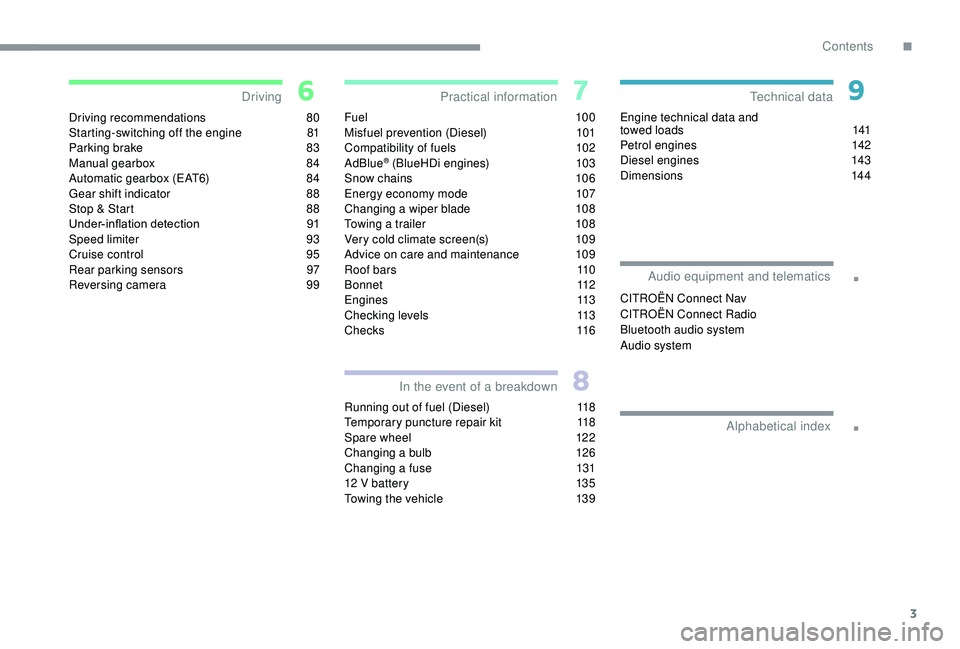
3
.
.
Driving recommendations 80
Starting-switching off the engine 8 1
Parking brake
8
3
Manual gearbox
8
4
Automatic gearbox (EAT6)
8
4
Gear shift indicator
8
8
Stop & Start
8
8
Under-inflation detection
9
1
Speed limiter
9
3
Cruise control
9
5
Rear parking sensors
9
7
Reversing camera
9
9Fuel 1
0 0
Misfuel prevention (Diesel) 1 01
Compatibility of fuels
1
02
AdBlue
® (BlueHDi engines) 1 03
Snow chains 1 06
Energy economy mode
1
07
Changing a wiper blade
1
08
Towing a trailer
1
08
Very cold climate screen(s)
1
09
Advice on care and maintenance
1
09
Roof bars
1
10
B o n n e t
112
Engines
1
13
Checking levels
1
13
C h e c k s
11
6
Running out of fuel (Diesel)
1
18
Temporary puncture repair kit
1
18
Spare wheel
1
22
Changing a bulb
1
26
Changing a fuse
1
31
12
V battery
1
35
Towing the vehicle
1
39Engine technical data and
towed loads
1
41
Petrol engines
1
42
Diesel engines 1 43
Dimensions 144
DrivingPractical information
In the event of a breakdown Technical data
Alphabetical index
Audio equipment and telematics
CITROËN Connect Nav
CITROËN Connect Radio
Bluetooth audio system
Audio system
.
Contents
Page 49 of 260

47
Turn off the defrosting of the rear
screen and side mirrors (depending on
the version) as soon as you consider it
necessary.
Because lower energy consumption
reduces fuel consumption.Advice
In order for these systems to be fully
effective, follow the operation and
maintenance guidelines below:
F
T
o ensure that the air is distributed
evenly, keep the external air intake
grilles at the base of the windscreen, the
nozzles, the vents, the air outlets and the
air extractor located in the back free from
obstructions.
F
O
perate the air conditioning system for
at least 5
to 10 minutes, once or twice a
month to keep it in per fect working order.
F
T
o prevent misting or deteriorating
air quality inside the passenger
compartment, you should not deactivate
the system for too long and avoid
extended operation of the air recirculation
system when driving.
F
E
nsure that the passenger compartment
filter is in good condition and have the
filter elements replaced regularly.
We recommend the use of a combined
passenger compartment filter. Thanks to
its special active additive, it contributes
to the purification of the air breathed by
the occupants and the cleanliness of the
passenger compartment (reduction of
allergic symptoms, bad odours and greasy
deposits). F
T o ensure correct operation of the air
conditioning system, you are also advised
to have it checked regularly according
to the Maintenance and Warranty Guide
recommendations.
F
I
f the system does not produce cold air,
switch it off and contact a CITROËN
dealer or a qualified workshop.
When towing the maximum load on a steep
gradient in high temperatures, switching off
the air conditioning increases the available
engine power and so improves the towing
ability.
3
Ease of use and comfort
Page 110 of 260
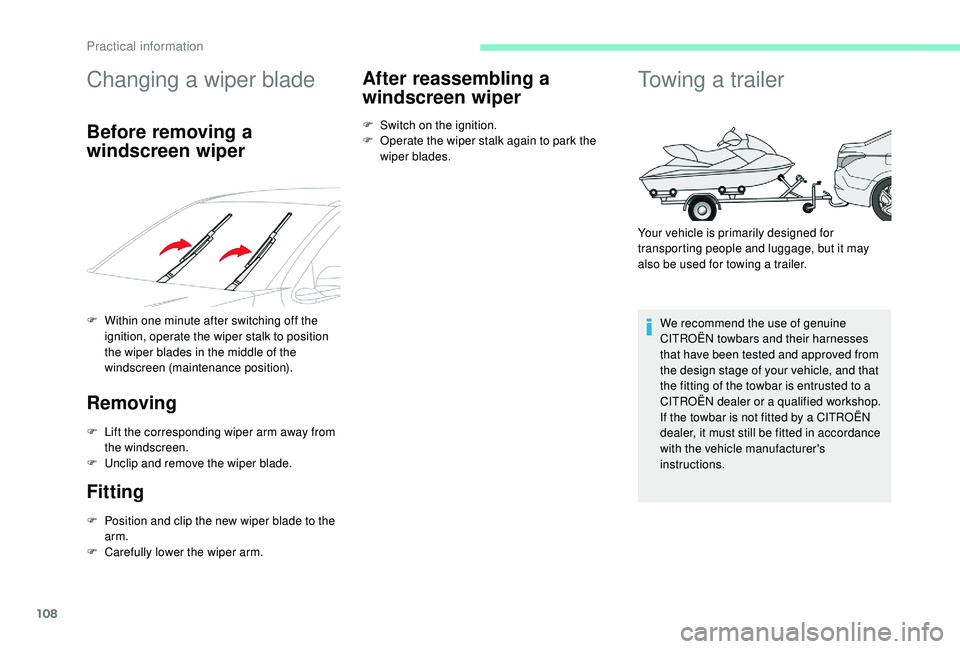
108
Changing a wiper blade
Before removing a
windscreen wiper
F Within one minute after switching off the ignition, operate the wiper stalk to position
the wiper blades in the middle of the
windscreen (maintenance position).
Removing
F Lift the corresponding wiper arm away from the windscreen.
F
U
nclip and remove the wiper blade.
Fitting
F Position and clip the new wiper blade to the arm.
F
C
arefully lower the wiper arm.
After reassembling a
windscreen wiper
F Switch on the ignition.
F O perate the wiper stalk again to park the
wiper blades.
Towing a trailer
Your vehicle is primarily designed for
transporting people and luggage, but it may
also be used for towing a trailer.
We recommend the use of genuine
CITROËN towbars and their harnesses
that have been tested and approved from
the design stage of your vehicle, and that
the fitting of the towbar is entrusted to a
CITROËN dealer or a qualified workshop.
If the towbar is not fitted by a CITROËN
dealer, it must still be fitted in accordance
with the vehicle manufacturer's
instructions.
Practical information
Page 111 of 260

109
Driving with a trailer places greater
demands on the towing vehicle and the
driver must take particular care.
For more information on Driving
recommendations, particularly when
towing, refer to the corresponding section.
Please observe the maximum authorised
towed weights, indicated on the
registration certificate or in your vehicle’s
technical data.
For more information on Weights (and the
towed loads which apply to your vehicle)
refer to the corresponding section.
Obser ve the legislation in force in the
country in which you are driving.Very cold climate
screen(s)
(Depending on the country of sale.)
Removable screen(s) which prevent snow
accumulating at the radiator cooling fan.
Depending on the version, you have one or two
screens.
Before fitting or removing a screen,
ensure that the engine is off and the
cooling fan has stopped.
Fitting
F Place the very cold climate screen in front of the front bumper.
F
P
ress around its edge to engage its fixing
clips one by one.
Removing
F Use a screwdriver as a lever to release each of the fixings of each screen in turn.
It is essential to remove the very cold
climate screen (or screens) in case of:
-
w
hen the exterior temperature exceeds
10°C,
-
w
hen towing,
-
a
t speeds above 75 mph (120 km/h).
Advice on care and
maintenance
Recommendations on the care and
maintenance of your vehicle are given in the
Maintenance and Warranty Guide.
7
Practical information
Page 124 of 260

122
Spare wheel
Procedure for changing a damaged wheel with
the spare wheel using the tools provided with
the vehicle.
Access to tooling
List of tools
1Wheelbrace.
For removing the hub cap and removing
the wheel bolts.
2 Jack with integrated crank.
Used to raise the vehicle.
3 Wheel bolt cover removal tool.
Removes the wheel bolt covers on alloy
wheels.
4 Towing eye.
For more information on Towing the vehicle ,
refer to the corresponding section. All of these tools are specific to your
vehicle and may vary according to the
level of equipment.
Do not use them for any other purposes.
The jack must only be used to change a
wheel with a damaged or punctured tyre.
Do not use any jack other than the one
supplied with this vehicle.
If the vehicle does not have its original jack,
contact a CITROËN dealer or a qualified
workshop to obtain the correct jack for it.
The jack meets European standards,
as defined in the Machinery Directive
2006/42/EC.
The jack does not require any
maintenance.
The tools are installed in the boot under the
f l o o r.
F
O
pen the boot.
F
L
ift the floor and remove it.
F
R
emove the storage box containing the
tools. These tools are specific to your vehicle and
may vary according to the equipment. Do not
use them for purposes other than those listed
below.
In the event of a breakdown
Page 127 of 260
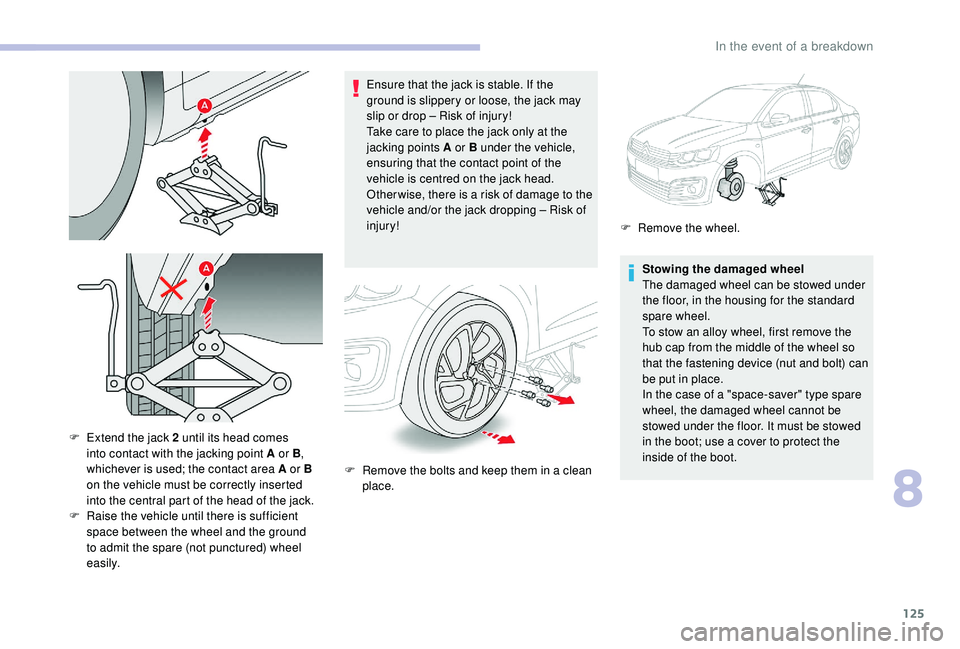
125
Ensure that the jack is stable. If the
ground is slippery or loose, the jack may
slip or drop – Risk of injury!
Take care to place the jack only at the
jacking points A or B under the vehicle,
ensuring that the contact point of the
vehicle is centred on the jack head.
Other wise, there is a risk of damage to the
vehicle and/or the jack dropping – Risk of
injury!Stowing the damaged wheel
The damaged wheel can be stowed under
the floor, in the housing for the standard
spare wheel.
To stow an alloy wheel, first remove the
hub cap from the middle of the wheel so
that the fastening device (nut and bolt) can
be put in place.
In the case of a "space-saver" type spare
wheel, the damaged wheel cannot be
stowed under the floor. It must be stowed
in the boot; use a cover to protect the
inside of the boot.
F
E
xtend the jack 2
until its head comes
into contact with the jacking point A or B ,
whichever is used; the contact area A or B
on the vehicle must be correctly inserted
into the central part of the head of the jack.
F
Ra
ise the vehicle until there is sufficient
space between the wheel and the ground
to admit the spare (not punctured) wheel
easily. F
R
emove the bolts and keep them in a clean
place. F
R
emove the wheel.
8
In the event of a breakdown
Page 141 of 260
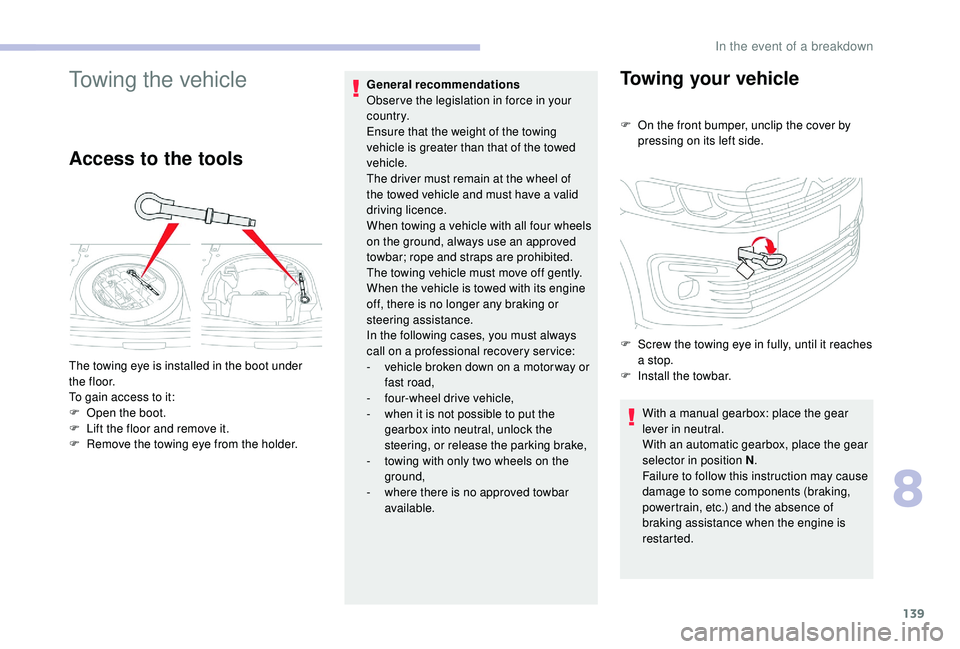
139
Towing the vehicle
Access to the tools
General recommendations
Obser ve the legislation in force in your
c o u nt r y.
Ensure that the weight of the towing
vehicle is greater than that of the towed
vehicle.
The driver must remain at the wheel of
the towed vehicle and must have a valid
driving licence.
When towing a vehicle with all four wheels
on the ground, always use an approved
towbar; rope and straps are prohibited.
The towing vehicle must move off gently.
When the vehicle is towed with its engine
off, there is no longer any braking or
steering assistance.
In the following cases, you must always
call on a professional recovery ser vice:
-
v
ehicle broken down on a motor way or
fast road,
-
f
our-wheel drive vehicle,
-
w
hen it is not possible to put the
gearbox into neutral, unlock the
steering, or release the parking brake,
-
t
owing with only two wheels on the
ground,
-
w
here there is no approved towbar
available.Towing your vehicle
F On the front bumper, unclip the cover by pressing on its left side.
The towing eye is installed in the boot under
t h e f l o o r.
To gain access to it:
F
O
pen the boot.
F
L
ift the floor and remove it.
F
R
emove the towing eye from the holder. F
S
crew the towing eye in fully, until it reaches
a stop.
F
I
nstall the towbar.With a manual gearbox: place the gear
lever in neutral.
With an automatic gearbox, place the gear
selector in position N .
Failure to follow this instruction may cause
damage to some components (braking,
powertrain, etc.) and the absence of
braking assistance when the engine is
restarted.
8
In the event of a breakdown
Page 142 of 260

140
Towing another vehicle
This type of towing is strictly prohibited
(risk of damage to your vehicle).
F
U
nlock the steering by turning the ignition
key one notch and release the parking
brake.
F
S
witch on the hazard warning lamps on
both vehicles.
F
S
et off gently, drive slowly and for a short
distance.
In the event of a breakdown
Page 143 of 260

141
Engine technical data and
towed loads
Engines
The engine technical data are indicated in the
vehicle's registration document, as well as in
sales brochures.The maximum power corresponds to the
value type-approved on a test bed, under
conditions defined in European legislation
(Directive 1999/99/EC).
For more information, contact a CITROËN
dealer or a qualified workshop.
Weights and towed loads
The maximum weights and towed loads for
your vehicle are indicated in the registration
document, as well as in sales brochures.
These values are also indicated on the
manufacturer's plate or label.
For more information, contact a CITROËN
dealer or a qualified workshop. The GTW values and the towed loads listed are
valid for a maximum altitude of 1,000
metres.
The towed load must be reduced by steps of
10% for each additional 1,000 metres.
The recommended nose weight is the vertical
load on the towbar ball (removable, with or
without tools).
GT W: Gross train weight.
High exterior temperatures may result
in a reduction in the per formance of the
vehicle to protect the engine. When the
exterior temperature is higher than 37°C,
limit the towed weight.
Towing using a lightly loaded vehicle can
adversely affect roadholding.
Braking distances are increased when
towing a trailer.
When using a vehicle to tow, never exceed
a speed of 60 mph (100 km/h) (obser ve
the local legislation in force). If the exterior temperature is high, it is
recommended that the engine be allowed
to idle for 1
to 2 minutes after the vehicle
comes to a stop, to facilitate its cooling.
9
Technical data
Page 256 of 260
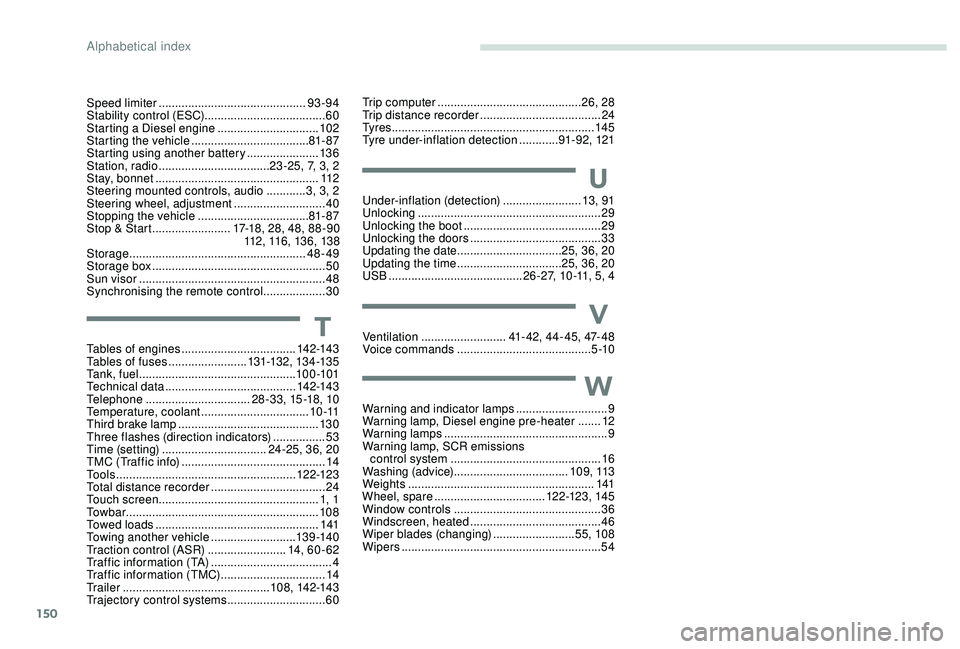
150
Speed limiter .............................................93 -94
Stability control (ESC)..................................... 60
Starting a Diesel engine
............................... 10
2
Starting the vehicle
.................................... 81
- 87
Starting using another battery
......................13 6
Station, radio
...............................
...23 -25, 7, 3, 2
Stay, bonnet
.................................................. 112
Steering mounted controls, audio
............ 3
, 3, 2
Steering wheel, adjustment
............................ 40
S
topping the vehicle
..................................81- 87
Stop & Start
........................ 17-18, 28, 48, 88 -90
112, 116, 136, 138
Storage
...................................................... 48-49
Storage box
..................................................... 50
Sun visor
...............................
..........................48
Synchronising the remote control
...................30
Tables of engines
................................... 142-143
Tables of fuses
........................131-132, 13 4 -13 5
Ta n k , f u e l
................................................10 0 -101
Technical data
........................................ 14
2-143
Telephone
..............................
..28 -33, 15 -18, 10
Temperature, coolant
.................................1 0 -11
Third brake lamp
........................................... 13 0
Three flashes (direction indicators)
................ 53
T
ime (setting)
................................ 24-25, 36, 20
TMC (Traffic info)
............................................ 14
T
o o l s
....................................................... 12 2-123
Total distance recorder
...................................24
Touch screen ................................................. 1, 1
To w b a r
...............................
............................108
Towed loads
.................................................. 141
Towing another vehicle
..........................13 9 -14 0
Traction control (ASR)
........................14, 6 0 - 62
Traffic information (TA)
.....................................4
Traffic information (TMC)
................................14
Tr a i l e r
...............
.............................. 10 8, 142-143
Trajectory control systems
..............................60U
nder-inflation (detection)
........................13, 91
Unlocking
........................................................29
Unlocking the boot
...............................
...........29
Unlocking the doors
........................................ 33
U
pdating the date
................................2
5, 36, 20
Updating the time
...............................
.25, 36, 20
USB
.........................................26 -27, 10 -11, 5, 4
Warning and indicator lamps
............................ 9
W
arning lamp, Diesel engine pre-heater
.......12
Warning lamps
..................................................9
Warning lamp, SCR emissions control system
..............................................16
Washing (advice) ................................... 1 0 9 , 113
Weights
...............
..........................................141
Wheel, spare
...............................
...12 2-123, 14 5
Window controls
.............................................36
Windscreen, heated
........................................46
Wiper blades (changing)
.........................55, 108
Wipers
.............................................................54
Ventilation
..........................41-42, 44-45, 47-48
Voice commands
.........................................5 -10
T
U
W
V
Trip computer ............................................ 26, 28
Trip distance recorder ..................................... 24
T
y r e s
.............................................................. 145
Tyre under-inflation detection
............91- 92, 121
Alphabetical index